A Retrospective and Foresight: Bibliometric Review of International Research on Strategic Management for Sustainability, 1991–2019
Abstract
1. Introduction
- RQ1: What is the size, growth trend, and geographic distribution of knowledge on strategic management for sustainability?
- RQ2: What journals, authors and documentation have influenced the international research on strategic management for sustainability?
- RQ3: What is the intellectual configuration of the strategic management for sustainability scholarship?
- RQ4: What contemporary foci in the strategic management for sustainability literature have the greatest interest from academics?
2. Conceptual Background of the Review
- Identification of key conceptual strands comprising this literature including strategic sustainability, strategic management for green, ecological, and environmental sustainability; social strategic management, and strategic management for sustainable development;
- One of the first literature reviews that combined the two research disciplines of corporate sustainability and strategic management and integrated corporate sustainability from a strategic management perspective;
- Finding of a growing importance of the integrated field based on the increasing trend in the number of on-topic publications in scientific journals from 1991–2013;
- Discovery that most literature focused heavily on theoretical frameworks and concepts, with the lack of empirical studies;
- Development of a “framework for the integration of corporate sustainability into strategic management of internal and external drivers, and factors supporting or hindering the integration of corporate sustainability into strategic management” (p. 2833)
3. Materials and Methods
3.1. Identification of Sources
3.2. Data Analysis
4. Results
4.1. Size, Growth Trend and Geographical Distribution of the SMS Literature
4.2. Leading Journals, Authors, and Documents of SMS Scholarship
4.3. Intellectual Configuration of the SMS Scholarship
4.4. Contemporary Foci in the SMS Literature
5. Discussion
5.1. Interpretation of the Findings
5.2. Practical Implication
5.3. Limitations
5.4. Suggestions for Future Research
6. Conclusions
Author Contributions
Funding
Acknowledgments
Conflicts of Interest
References
- Brundtland, G.H. Our Common Future 1987; World Commission on Environment and Development: Brussels, Belgium, 2010. [Google Scholar]
- The World Commission on Economic Development. El Desarrollo Sostenible, Una Guía Sobre Nuestro Futuro Común: El Informe De La Comisión Mundial Sobre el Medio Ambiente y el Desarrollo; Oxford University Press: Oxford, UK, 1987. [Google Scholar]
- Hassan, S.; Haddawy, P.; Zhu, J. A bibliometric study of the world’s research activity in sustainable development and its sub-areas using scientific literature. Scientometrics 2014, 99, 549–579. [Google Scholar] [CrossRef]
- Intergovernmental Panel for Private Change. In IPCC Special Report on Climate Change, Desertification, Land Degradation, Sustainable Land Management, Food Security, and Greenhouse gas fluxes in Terrestrial Ecosystems; IPCC: Geneva, Switzerland, 2019.
- Stockholm Resilience Centre Annual. In Annual Report; Stockholm Resilience Centre: Stockholm, Sweden, 2018.
- Sustainable Development Solution Networks. In SDSN Networks in Action; SDSN: New York, NY, USA, 2019.
- Bansal, P.; Song, H.C. Similar but not the same: Differentiating corporate sustainability from corporate responsibility. Acad. Manag. Ann. 2017, 11, 105–149. [Google Scholar] [CrossRef]
- Hahn, T.; Pinkse, J.; Preuss, L.; Figge, F. Tensions in corporate sustainability: Towards an integrative framework. J. Bus. Ethics 2015, 127, 297–316. [Google Scholar] [CrossRef]
- Bracker, J. The historical development of the strategic management concept. Acad. Manag. Rev. 1980, 5, 219–224. [Google Scholar] [CrossRef]
- Ansoff, H.I. Corporate Strategy; McGraw Hill: New York, NY, USA, 1965. [Google Scholar]
- Mintzberg, H. Patterns in Strategy Formation. Manage. Sci. 1978, 24, 934–948. [Google Scholar] [CrossRef]
- Mintzberg, H. The Structuring of Organizations; Prentice-Hall: Engle-Wood Cliffs, NJ, USA; New York, NY, USA, 1989. [Google Scholar]
- Porter, M.E.; Kramer, M.R. The link between competitive advantage and corporate social responsibility. Harv. Bus. Rev. 2006, 84, 78–92. [Google Scholar]
- Schendel, D.; Hofer, C.W. Strategic Management: A New View of Business Policy and Planning; Little Brown: Boston, MA, USA, 1979. [Google Scholar]
- Porter, M.E.; Kramer, M.R. The big idea: Creating shared value, rethinking capitalism. Harv. Bus. Rev. 2011, 89, 62–77. [Google Scholar]
- Epstein, M.J. Making Sustainability Work: Best Practices in Managing and Measuring Corporate Social, Environmental and Economic Impacts; Greenleft Publishing Limited: Sheffield, UK, 2018. [Google Scholar]
- Suriyankietkaew, S. Taking the long view on resilience and sustainability with 5Cs at B. Grimm. Glob. Bus. Organ. Excel. 2019, 38, 11–17. [Google Scholar] [CrossRef]
- Ferreira, J.J.M.; Fernandes, C.I.; Ratten, V. A co-citation bibliometric analysis of strategic management research. Scientometrics 2016, 109, 1–32. [Google Scholar] [CrossRef]
- Nerur, S.P.; Rasheed, A.A.; Natarajan, V. The intellectual structure of the strategic management field: An author co-citation analysis. Strateg. Manag. J. 2008, 29, 319–336. [Google Scholar] [CrossRef]
- Renaud, A.; Walsh, I.; Kalika, M. Is SAM still alive? A bibliometric and interpretive mapping of the strategic alignment research field. J. Strateg. Inf. Syst. 2016, 25, 75–103. [Google Scholar] [CrossRef]
- Vogel, R.; Güttel, W.H. The dynamic capability view in strategic management: A bibliometric review. Int. J. Manag. Rev. 2013, 15, 426–446. [Google Scholar] [CrossRef]
- Van Eck, N.J.; Waltman, L. Citation-based clustering of publications using CitNetExplorer and VOSviewer. Scientometrics 2017, 111, 1053–1070. [Google Scholar] [CrossRef] [PubMed]
- Zupic, I.; Čater, T. Bibliometric methods in management and organization. Organ. Res. Methods 2015, 18, 429–472. [Google Scholar] [CrossRef]
- Hallinger, P.; Suriyankietkaew, S. Science mapping of the knowledge base on sustainable leadership, 1990–2018. Sustainability 2018, 10, 4846. [Google Scholar] [CrossRef]
- Engert, S.; Rauter, R.; Baumgartner, R.J. Exploring the integration of corporate sustainability into strategic management: A literature review. J. Clean. Prod. 2016, 112, 2833–2850. [Google Scholar] [CrossRef]
- Figge, F.; Hahn, T.; Schaltegger, S.; Wagner, M. The sustainability balanced scorecard–linking sustainability management to business strategy. Bus. Strateg. Environ. 2002, 11, 269–284. [Google Scholar] [CrossRef]
- Radomska, J. The concept of sustainable strategy implementation. Sustainability 2015, 7, 15847–15856. [Google Scholar] [CrossRef]
- Stead, J.G.; Stead, W.E. The coevolution of sustainable strategic management in the global marketplace. Organ. Environ. 2013, 26, 162–183. [Google Scholar] [CrossRef]
- Stead, J.G.; Stead, W.E. Sustainable Strategic Management; Routledge: New York, NY, USA, 2014. [Google Scholar]
- Zott, C.; Amit, R.; Massa, L. The business model: Recent developments and future research. J. Manag. 2011, 37, 1019–1042. [Google Scholar]
- Teece, D.J. Business models, business strategy and innovation. Long Range Plan. 2010, 43, 172–194. [Google Scholar] [CrossRef]
- Evans, S.; Vladimirova, D.; Holgado, M.; Van Fossen, K.; Yang, M.; Silva, E.A.; Barlow, C.Y. Business model innovation for sustainability: Towards a unified perspective for creation of sustainable business models. Bus. Strateg. Environ. 2017, 26, 597–608. [Google Scholar] [CrossRef]
- Linnenluecke, M.K.; Griffiths, A. Firms and sustainability: Mapping the intellectual origins and structure of the corporate sustainability field. Glob. Environ. Chang. 2013, 23, 382–391. [Google Scholar] [CrossRef]
- Fahimnia, B.; Sarkis, J.; Davarzani, H. Green supply chain management: A review and bibliometric analysis. Int. J. Prod. Econ. 2015, 162, 101–114. [Google Scholar] [CrossRef]
- Mongeon, P.; Paul-Hus, A. The journal coverage of Web of Science and Scopus: A comparative analysis. Scientometrics 2016, 106, 213–228. [Google Scholar] [CrossRef]
- Falagas, M.E.; Pitsouni, E.I.; Malietzis, G.A.; Pappas, G. Comparison of PubMed, Scopus, web of science, and Google scholar: Strengths and weaknesses. FASEB J. 2008, 22, 338–342. [Google Scholar] [CrossRef]
- Moher, D.; Liberati, A.; Tetzlaff, J.; Altman, D.G. Preferred reporting items for systematic reviews and meta-analyses: The PRISMA statement. Ann. Internal Med. 2009, 151, 264–269. [Google Scholar] [CrossRef]
- Osareh, F. Bibliometrics, citation analysis and co-citation analysis: A review of literature I. Libri 1996, 46, 149–158. [Google Scholar] [CrossRef]
- Hallinger, P. Science mapping the knowledge base on educational leadership and management from the emerging regions of Asia, Africa and Latin America, 1965–2018. Edu. Manag. Adm. Leadersh. 2019. [Google Scholar] [CrossRef]
- Van Eck, N.J.; Waltman, L. Visualizing bibliometric networks. In Measuring Scholarly Impact; Springer: Cham, Switzerland, 2014; pp. 285–320. [Google Scholar]
- Chen, C.; Ibekwe-SanJuan, F.; Hou, J. The structure and dynamics of cocitation clusters: A multiple-perspective cocitation analysis. J. Am. Soc. Inf. Sci. Technol. 2010, 61, 1386–1409. [Google Scholar] [CrossRef]
- Boyack, K.W.; Klavans, R. Co-citation analysis, bibliographic coupling, and direct citation: Which citation approach represents the research front most accurately? J. Am. Soc. Inf. Sci. Technol. 2010, 61, 2389–2404. [Google Scholar] [CrossRef]
- Cobo, M.J.; López-Herrera, A.G.; Herrera-Viedma, E.; Herrera, F. Science mapping software tools: Review, analysis, and cooperative study among tools. J. Am. Soc. Inf. Sci. Technol. 2011, 62, 1382–1402. [Google Scholar] [CrossRef]
- Hallinger, P. Science mapping the knowledge base on educational leadership and management in Africa, 1960–2018. Sch. Leadersh. Manag. 2018, 39, 537–560. [Google Scholar] [CrossRef]
- McNie, E.C. Reconciling the supply of scientific information with user demands: An analysis of the problem and review of the literature. Environ. Sci. Policy 2007, 10, 17–38. [Google Scholar] [CrossRef]
- Wagener, T.; Sivapalan, M.; Troch, P.A.; McGlynn, B.L.; Harman, C.J.; Gupta, H.V.; Kumar, P.; Rao, P.S.C.; Basu, N.B.; Wilson, J.S. The future of hydrology: An evolving science for a changing world. Water Resour. Res. 2010, 46. [Google Scholar] [CrossRef]
- Ahern, J. From fail-safe to safe-to-fail: Sustainability and resilience in the new urban world. Landsc. Urban Plan. 2011, 100, 341–343. [Google Scholar] [CrossRef]
- Iglesias, A.; Garrote, L.; Flores, F.; Moneo, M. Challenges to manage the risk of water scarcity and climate change in the Mediterranean. Water Resour. Manag. 2007, 21, 775–788. [Google Scholar] [CrossRef]
- Robèrt, K.-H. Tools and concepts for sustainable development, how do they relate to a general framework for sustainable development, and to each other? J. Clean. Prod. 2000, 8, 243–254. [Google Scholar] [CrossRef]
- He, W.; Li, G.; Ma, X.; Wang, H.; Huang, J.; Xu, M.; Huang, C. WEEE recovery strategies and the WEEE treatment status in China. J. Hazard. Mater. 2006, 136, 502–512. [Google Scholar] [CrossRef]
- Baumgartner, R.J.; Ebner, D. Corporate sustainability strategies: Sustainability profiles and maturity levels. Sustain. Dev. 2010, 18, 76–89. [Google Scholar] [CrossRef]
- Scholz, R.W.; Lang, D.J.; Wiek, A.; Walter, A.I.; Stauffacher, M. Transdisciplinary case studies as a means of sustainability learning: Historical framework and theory. Int. J. Sustain. High. Educ. 2006, 7, 226–251. [Google Scholar] [CrossRef]
- Reynolds, M.; Foulkes, J.; Furbank, R.; Griffiths, S.; King, J.; Murchie, E.; Parry, M.; Slafer, G. Achieving yield gains in wheat. Plant Cell Environ. 2012, 35, 1799–1823. [Google Scholar] [CrossRef] [PubMed]
- Aragón-Correa, J.A.; Rubio-Lopez, E.A. Proactive corporate environmental strategies: Myths and misunderstandings. Long Range Plan. 2007, 40, 357–381. [Google Scholar] [CrossRef]
- Makropoulos, C.K.; Natsis, K.; Liu, S.; Mittas, K.; Butler, D. Decision support for sustainable option selection in integrated urban water management. Environ. Model. Softw. 2008, 23, 1448–1460. [Google Scholar] [CrossRef]
- Subramoniam, R.; Huisingh, D.; Chinnam, R.B. Remanufacturing for the automotive aftermarket-strategic factors: Literature review and future research needs. J. Clean. Prod. 2009, 17, 1163–1174. [Google Scholar] [CrossRef]
- Moore, S.B.; Manring, S.L. Strategy development in small and medium sized enterprises for sustainability and increased value creation. J. Clean. Prod. 2009, 17, 276–282. [Google Scholar] [CrossRef]
- Maxwell, D.; Sheate, W.; Van Der Vorst, R. Functional and systems aspects of the sustainable product and service development approach for industry. J. Clean. Prod. 2006, 14, 1466–1479. [Google Scholar] [CrossRef]
- Figge, F.; Hahn, T. The cost of sustainability capital and the creation of sustainable value by companies. J. Ind. Ecol. 2005, 9, 47–58. [Google Scholar] [CrossRef]
- Tal, A. Seeking sustainability: Israel’s evolving water management strategy. Science 2006, 313, 1081–1084. [Google Scholar] [CrossRef]
- Ny, H.; MacDonald, J.P.; Broman, G.; Yamamoto, R.; Robért, K.H. Sustainability constraints as system boundaries: An approach to making life-cycle management strategic. J. Ind. Ecol. 2006, 10, 61–77. [Google Scholar] [CrossRef]
- Petrini, M.; Pozzebon, M. Managing sustainability with the support of business intelligence: Integrating socio-environmental indicators and organisational context. J. Strateg. Inf. Syst. 2009, 18, 178–191. [Google Scholar] [CrossRef]
- Ceschin, F. Critical factors for implementing and diffusing sustainable product-Service systems: Insights from innovation studies and companies’ experiences. J. Clean. Prod. 2013, 45, 74–88. [Google Scholar] [CrossRef]
- Van Hoey, G.; Borja, A.; Birchenough, S.; Buhl-Mortensen, L.; Degraer, S.; Fleischer, D.; Kerckhof, F.; Magni, P.; Muxika, I.; Reiss, H. The use of benthic indicators in Europe: From the Water Framework Directive to the Marine Strategy Framework Directive. Mar. Pollut. Bull. 2010, 60, 2187–2196. [Google Scholar] [CrossRef] [PubMed]
- Schrettle, S.; Hinz, A.; Scherrer-Rathje, M.; Friedli, T. Turning sustainability into action: Explaining firms’ sustainability efforts and their impact on firm performance. Int. J. Prod. Econ. 2014, 147, 73–84. [Google Scholar] [CrossRef]
- McCain, K.W. Mapping authors in intellectual space: A technical overview. J. Am. Soc. Inf. Sci. 1990, 41, 433–443. [Google Scholar] [CrossRef]
- Small, H. Visualizing science by citation mapping. J. Am. Soc. Inf. Sci. 1999, 50, 799–813. [Google Scholar] [CrossRef]
- Pilkington, A.; Meredith, J. The evolution of the intellectual structure of operations management—1980–2006: A citation/co-citation analysis. J. Oper. Manag. 2009, 27, 185–202. [Google Scholar] [CrossRef]
- White, H.D.; McCain, K.W. Visualizing a discipline: An author co-citation analysis of information science, 1972–1995. J. Am. Soc. Inf. Sci. 1998, 49, 327–355. [Google Scholar]
- Porter, M.E. Michael, E. Porter on Competition and Strategy; Harvard Business School Press: Boston, MA, USA, 1991. [Google Scholar]
- Elkington, J. Cannibals with Forks: The Triple Bottom Line of Sustainability; New Society Publishers: Gabriola Island, UK, 1998. [Google Scholar]
- Elkington, J. Enter the triple bottom line. In The Triple Bottom Line; Routledge: London, UK, 2013; pp. 23–38. [Google Scholar]
- Prahalad, C.; Hart, S.L. Strategies for the bottom of the pyramid: Creating sustainable development. Ann. Arbor. 1999, 1001, 48109. [Google Scholar]
- Baumgartner, R. Corporate sustainability performance: Methods and illustrative examples. Int. J. Sustain. Dev. Plan. 2008, 3, 117–131. [Google Scholar] [CrossRef]
- Baumgartner, R.J. Managing corporate sustainability and CSR: A conceptual framework combining values, strategies and instruments contributing to sustainable development. Corp. Soc. Responsib. Environ. Manag. 2014, 21, 258–271. [Google Scholar] [CrossRef]
- Hahn, T.; Figge, F.; Pinkse, J.; Preuss, L. Trade-offs in corporate sustainability: You can’t have your cake and eat it. Bus. Strateg. Environ. 2010, 19, 217–229. [Google Scholar] [CrossRef]
- Schaltegger, S.; Wagner, M. Integrative management of sustainability performance, measurement and reporting. Int. J. Acc. Audit. Perform. Eval. 2006, 3, 1–19. [Google Scholar] [CrossRef]
- Schaltegger, S.; Wagner, M. Managing and measuring the business case for sustainability: Capturing the relationship between sustainability performance, business competitiveness and economic performance. In Managing the Business Case for Sustainability; Routledge: London, UK, 2017; pp. 1–27. [Google Scholar]
- Chang, N.-B.; Davila, E.; Dyson, B.; Brown, R. Optimal design for sustainable development of a material recovery facility in a fast-growing urban setting. Waste Manag. 2005, 25, 833–846. [Google Scholar] [CrossRef] [PubMed]
- Chang, N.-B.; Pires, A. Sustainable Solid Waste Management: A Systems Engineering Approach; John Wiley & Sons: Hoboken, NJ, USA, 2015. [Google Scholar]
- Zhang, X.; Deng, S.; Zhang, Y.; Yang, G.; Li, L.; Qi, H.; Xiao, H.; Wu, J.; Wang, Y.; Shen, F. Emergy evaluation of the impact of waste exchanges on the sustainability of industrial systems. Ecol. Eng. 2011, 37, 206–216. [Google Scholar] [CrossRef]
- Zhang, X.H.; Deng, S.; Jiang, W.; Zhang, Y.; Peng, H.; Li, L.; Yang, G.; Li, Y. Emergy evaluation of the sustainability of two industrial systems based on wastes exchanges. Resour. Conserv. Recycl. 2010, 55, 182–195. [Google Scholar] [CrossRef]
- Su, S.; Jiang, Z.; Zhang, Q.; Zhang, Y. Transformation of agricultural landscapes under rapid urbanization: A threat to sustainability in Hang-Jia-Hu region, China. Appl. Geogr. 2011, 31, 439–449. [Google Scholar] [CrossRef]
- Zhang, Y.; Li, Y.; Jiang, L.; Tian, C.; Li, J.; Xiao, Z. Potential of perennial crop on environmental sustainability of agriculture. Procedia Environ. Sci. 2011, 10, 1141–1147. [Google Scholar] [CrossRef]
- Finnveden, G.; Ekvall, T.; Arushanyan, Y.; Bisaillon, M.; Henriksson, G.; Gunnarsson Östling, U.; Söderman, M.; Sahlin, J.; Stenmarck, Å.; Sundberg, J. Policy instruments towards a sustainable waste management. Sustainability 2013, 5, 841–881. [Google Scholar] [CrossRef]
- Robèrt, K.H.; Broman, G.; Waldron, D.; Ny, H.; Byggeth, S.; Cook, D.; Johansson, L.; Oldmark, J.; Basile, G.; Haraldsson, H.V. Strategic Leadership towards Sustainability; Department of Mechanical Engineering at BTH: Blekinge, Sweden, 2004. [Google Scholar]
- Holmberg, J.; Lundqvist, U.; Robèrt, K.-H.; Wackernagel, M. The ecological footprint from a systems perspective of sustainability. Int. J. Sustain. Dev. World Ecol. 1999, 6, 17–33. [Google Scholar] [CrossRef]
- Loorbach, D. Transition management for sustainable development: A prescriptive, complexity-based governance framework. Governance 2010, 23, 161–183. [Google Scholar] [CrossRef]
- Loorbach, D.; Rotmans, J. Managing transitions for sustainable development. In Understanding Industrial Transformation; Springer: Netherland, 2006; pp. 187–206. [Google Scholar]
- Kemp, R.; Loorbach, D. Governance for Sustainability through Transition Management; Open Meeting of Human Dimensions of Global Environmental Change Research Community: Montreal, QC, Canada, 2003; p. 2003. [Google Scholar]
- Kemp, R.; Loorbach, D.; Rotmans, J. Transition management as a model for managing processes of co-evolution towards sustainable development. Int. J. Sustain. Dev. Ecol. 2007, 14, 78–91. [Google Scholar] [CrossRef]
- Rotmans, J.; Kemp, R.; Van Asselt, M. More evolution than revolution: Transition management in public policy. Foresight 2001, 3, 15–31. [Google Scholar] [CrossRef]
- Smith, A.; Raven, R. What is protective space? Reconsidering niches in transitions to sustainability. Res. Policy 2012, 41, 1025–1036. [Google Scholar] [CrossRef]
- Smith, A.; Voß, J.-P.; Grin, J. Innovation studies and sustainability transitions: The allure of the multi-level perspective and its challenges. Res. Policy 2010, 39, 435–448. [Google Scholar] [CrossRef]
- Mintzberg, H. Strategy-making in three modes. Calif. Manag. Rev. 1973, 16, 44–53. [Google Scholar] [CrossRef]
- Mintzberg, H. The strategy concept I: Five Ps for strategy. Calif. Manag. Rev. 1987, 30, 11–24. [Google Scholar] [CrossRef]
- Mintzberg, H. Crafting Strategy; Harvard Business Review: Boston, MA, USA, 1987. [Google Scholar]
- Mintrom, M. Policy entrepreneurs and the diffusion of innovation. Am. J. Political Sci. 1997, 738–770. [Google Scholar] [CrossRef]
- Huitema, D.; Mostert, E.; Egas, W.; Moellenkamp, S.; Pahl-Wostl, C.; Yalcin, R. Adaptive water governance: Assessing the institutional prescriptions of adaptive (co-) management from a governance perspective and defining a research agenda. Ecol. Soc. 2009, 14, 26. [Google Scholar] [CrossRef]
- Meijer, I.; Hekkert, M.P. Managing uncertainties in the transition towards sustainability: Cases of emerging energy technologies in the Netherlands. J. Environ. Policy Plan. 2007, 9, 281–298. [Google Scholar] [CrossRef]
- Meijer, I.; Koppenjan, J.; Pruyt, E.; Negro, S.; Hekkert, M. The influence of perceived uncertainty on entrepreneurial action in the transition to a low-emission energy infrastructure: The case of biomass combustion in The Netherlands. Technol. Forecast. Soc. Chang. 2010, 77, 1222–1236. [Google Scholar] [CrossRef]
- Sabatier, P.; Mazmanian, D. The implementation of public policy: A framework of analysis. Policy Stud. J. 1980, 8, 538–560. [Google Scholar] [CrossRef]
- Seuring, S. Supply chain management for sustainable products–insights from research applying mixed methodologies. Bus. Strateg. Environ. 2011, 20, 471–484. [Google Scholar] [CrossRef]
- Seuring, S. A review of modeling approaches for sustainable supply chain management. Decis. Support Syst. 2013, 54, 1513–1520. [Google Scholar] [CrossRef]
- Seuring, S.; Müller, M. From a literature review to a conceptual framework for sustainable supply chain management. J. Clean. Prod. 2008, 16, 1699–1710. [Google Scholar] [CrossRef]
- Seuring, S.; Müller, M. Core issues in sustainable supply chain management–a Delphi study. Bus. Strateg. Environ. 2008, 17, 455–466. [Google Scholar] [CrossRef]
- Seuring, S.; Sarkis, J.; Müller, M.; Rao, P. Sustainability and Supply Chain Management—An Introduction to the Special Issue. J. Clean. Prod. 2008, 16, 1545–1551. [Google Scholar] [CrossRef]
- Sarkis, J. A strategic decision framework for green supply chain management. J. Clean. Prod. 2003, 11, 397–409. [Google Scholar] [CrossRef]
- Krause, D.R.; Vachon, S.; Klassen, R.D. Special topic forum on sustainable supply chain management: Introduction and reflections on the role of purchasing management. J. Supply Chain Manag. 2009, 45, 18–25. [Google Scholar] [CrossRef]
- Vachon, S.; Halley, A.; Beaulieu, M. Aligning competitive priorities in the supply chain: The role of interactions with suppliers. Int. J. Oper. Prod. Manag. 2009, 29, 322–340. [Google Scholar] [CrossRef]
- Vachon, S.; Mao, Z. Linking supply chain strength to sustainable development: A country-level analysis. J. Clean. Prod. 2008, 16, 1552–1560. [Google Scholar] [CrossRef]
- Klassen, R.D.; Vereecke, A. Social issues in supply chains: Capabilities link responsibility, risk (opportunity), and performance. Int. J. Prod. Econ. 2012, 140, 103–115. [Google Scholar] [CrossRef]
- Sueyoshi, T. Extended DEA-discriminant analysis. Eur. J. Oper. Res. 2001, 131, 324–351. [Google Scholar] [CrossRef]
- Sueyoshi, T. Mixed integer programming approach of extended DEA–discriminant analysis. Eur. J. Oper. Res. 2004, 152, 45–55. [Google Scholar] [CrossRef]
- Sueyoshi, T.; Goto, M. Slack-adjusted DEA for time series analysis: Performance measurement of Japanese electric power generation industry in 1984–1993. Eur. J. Oper. Res. 2001, 133, 232–259. [Google Scholar] [CrossRef]
- Sueyoshi, T.; Goto, M. DEA approach for unified efficiency measurement: Assessment of Japanese fossil fuel power generation. Energy Econ. 2011, 33, 292–303. [Google Scholar] [CrossRef]
- Sueyoshi, T.; Goto, M. DEA radial measurement for environmental assessment and planning: Desirable procedures to evaluate fossil fuel power plants. Energy Policy 2012, 41, 422–432. [Google Scholar] [CrossRef]
- Sueyoshi, T.; Goto, M. DEA environmental assessment of coal fired power plants: Methodological comparison between radial and non-radial models. Energy Econ. 2012, 34, 1854–1863. [Google Scholar] [CrossRef]
- Sueyoshi, T.; Goto, M.; Ueno, T. Performance analysis of US coal-fired power plants by measuring three DEA efficiencies. Energy Policy 2010, 38, 1675–1688. [Google Scholar] [CrossRef]
- Hart, S.L. A natural-resource-based view of the firm. Acad. Manag. Rev. 1995, 20, 986–1014. [Google Scholar] [CrossRef]
- Hart, S.L. Beyond greening: Strategies for a sustainable world. Harv. Bus. Rev. 1997, 75, 66–77. [Google Scholar]
- Partidario, M.R. A strategic advocacy role in SEA for sustainability. J. Environ. Assess. Policy Manag. 2015, 17, 1550015. [Google Scholar] [CrossRef]
- Dillon, P.S. Implications of industrial ecology for firms. In The Greening of Industrial Ecosystems; National Academy Press: Washington, DC, USA, 1994; pp. 201–207. [Google Scholar]
- Richards, D.J.; Allenby, B.R. The Greening of Industrial Ecosystems; National Academies Press: Washington, DC, USA, 1994. [Google Scholar]
- Shrivastava, P. The role of corporations in achieving ecological sustainability. Acad. Manag. Rev. 1995, 20, 936–960. [Google Scholar] [CrossRef]
- Cullen, J.G. Educating business students about sustainability: A bibliometric review of current trends and research needs. J. Bus. Ethics 2017, 145, 429–439. [Google Scholar] [CrossRef]
- Sachs, J.D. From millennium development goals to sustainable development goals. Lancet 2012, 379, 2206–2211. [Google Scholar] [CrossRef]
- Griggs, D.; Stafford-Smith, M.; Gaffney, O.; Rockström, J.; Öhman, M.C.; Shyamsundar, P.; Steffen, W.; Glaser, G.; Kanie, N.; Noble, I. Policy: Sustainable development goals for people and planet. Nature 2013, 495, 305. [Google Scholar] [CrossRef]
- Dyllick, T.; Hockerts, K. Beyond the business case for corporate sustainability. Bus. Strateg. Environ. 2002, 11, 130–141. [Google Scholar] [CrossRef]
- Van Marrewijk, M. Concepts and definitions of CSR and corporate sustainability: Between agency and communion. J. Bus. Ethics 2003, 44, 95–105. [Google Scholar] [CrossRef]
- Van Marrewijk, M.; Werre, M. Multiple levels of corporate sustainability. J. Bus. Ethics 2003, 44, 107–119. [Google Scholar] [CrossRef]
- Schaltegger, S.; Wagner, M. Managing the Business Case for Sustainability: The Integration of Social, Environmental and Economic Performance; Routledge: New York, NY, USA, 2017. [Google Scholar]
- Bonn, I.; Fisher, J. Sustainability: The missing ingredient in strategy. J. Bus. Strategy 2011, 32, 5–14. [Google Scholar] [CrossRef]
- Folke, C.; Biggs, R.; Norstrom, A.V.; Reyers, B.; Rockstrom, J. Social-ecological resilience and biosphere-based sustainability science. Ecol. Soc. 2016. [Google Scholar] [CrossRef]
- Folke, C.; Carpenter, S.; Elmqvist, T.; Gunderson, L.; Holling, C.S.; Walker, B. Resilience and sustainable development: Building adaptive capacity in a world of transformations. J. Hum. Environ. 2002, 31, 437–441. [Google Scholar] [CrossRef] [PubMed]
- Kemp, R.; Parto, S.; Gibson, R.B. Governance for sustainable development: Moving from theory to practice. Int. J. Sust. Dev. 2005, 8, 12–30. [Google Scholar] [CrossRef]
- Kemp, R.; Schot, J.; Hoogma, R. Regime shifts to sustainability through processes of niche formation: The approach of strategic niche management. Technol. Anal. Strateg. Manag. 1998, 10, 175–198. [Google Scholar] [CrossRef]
- Suriyankietkaew, S.; Kantamara, P. Business ethics and spirituality for corporate sustainability: A Buddhism perspective. J. Manag. Spiritual. Relig. 2019, 16, 264–289. [Google Scholar] [CrossRef]
- Suriyankietkaew, S.; Avery, G.C. Sustainable leadership practices driving financial performance: Empirical evidence from Thai SMEs. Sustainability 2016, 8, 327. [Google Scholar] [CrossRef]
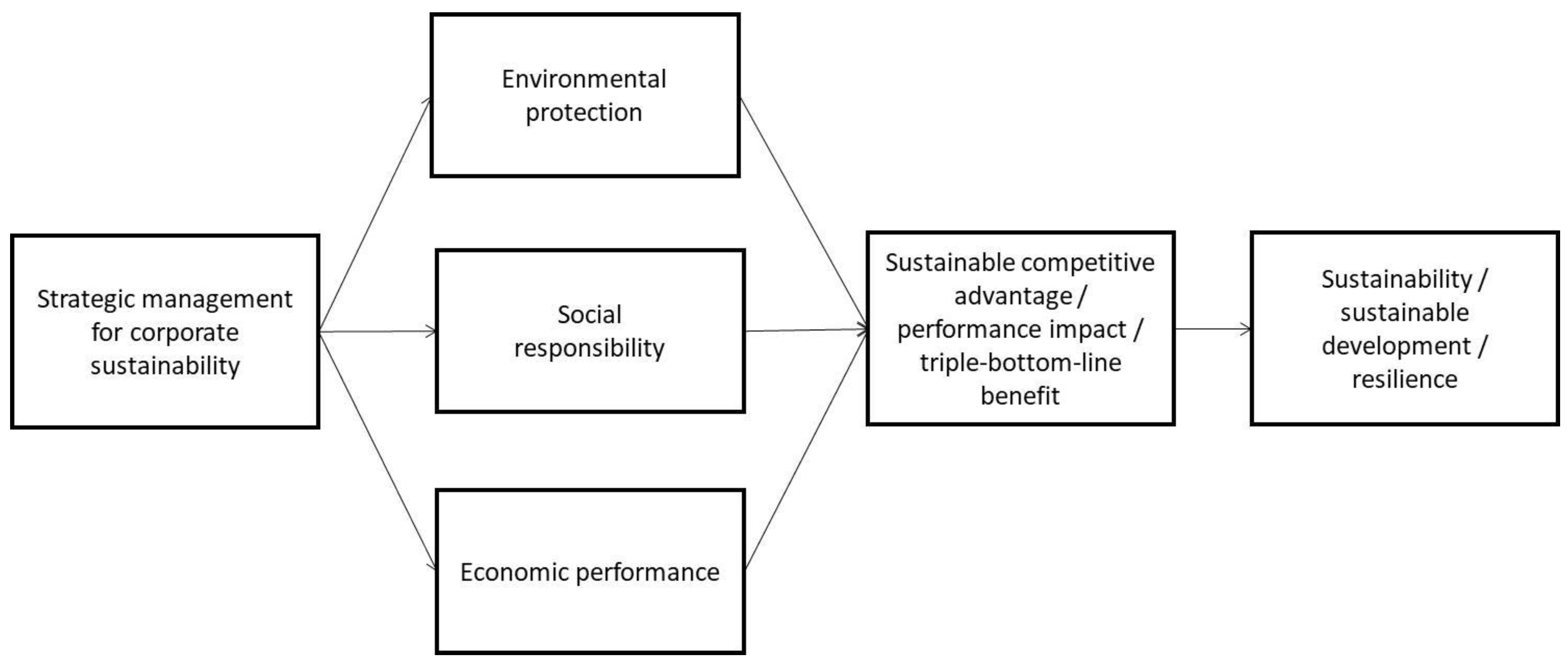
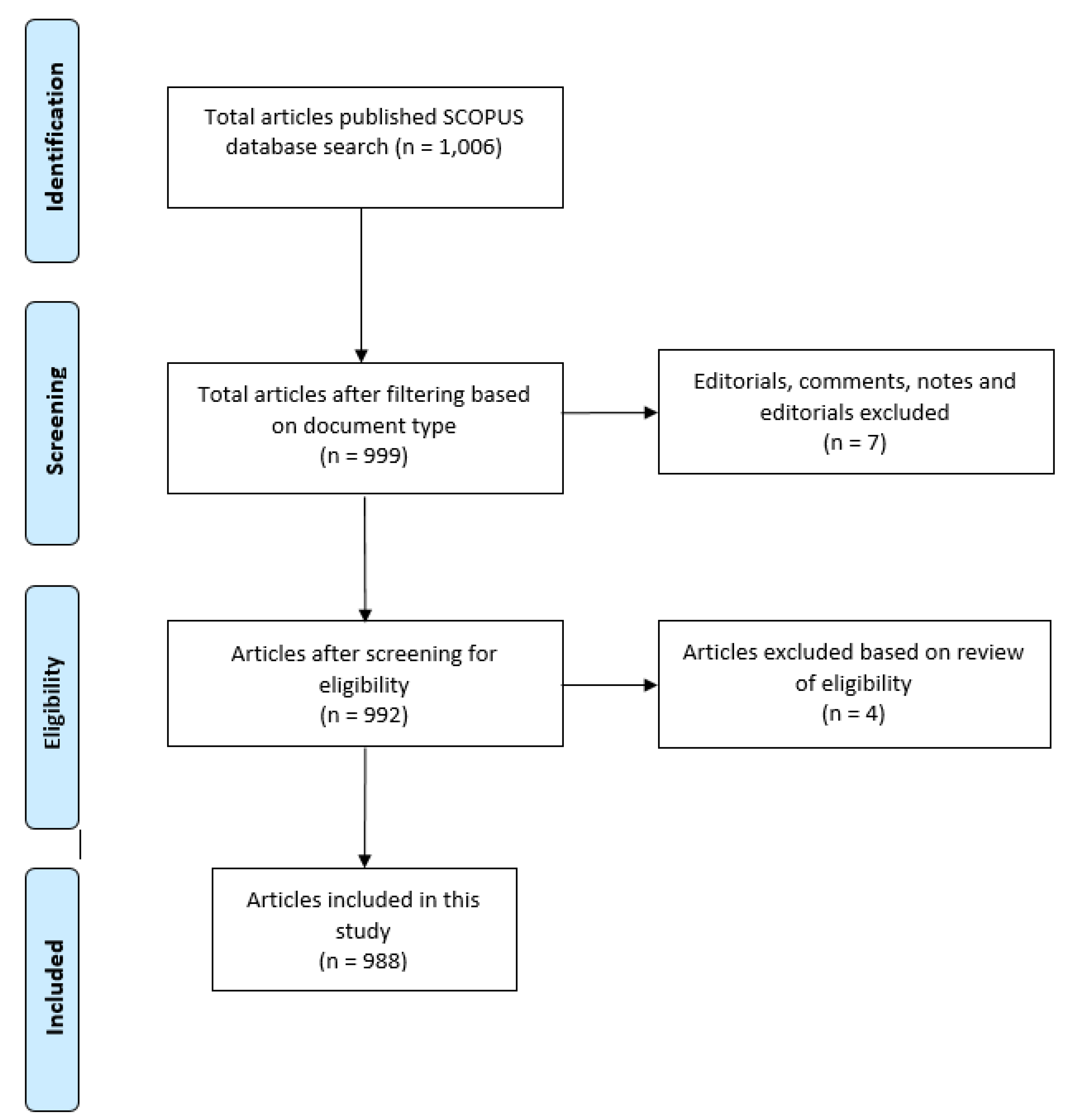
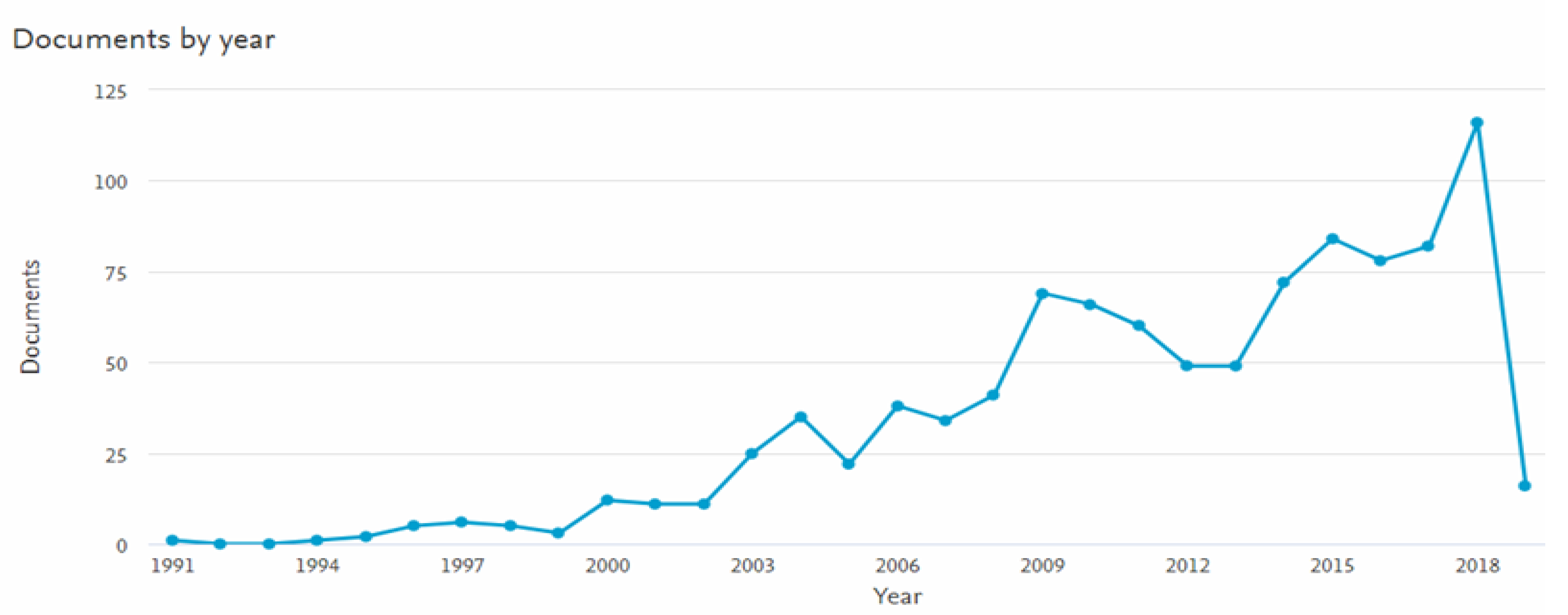
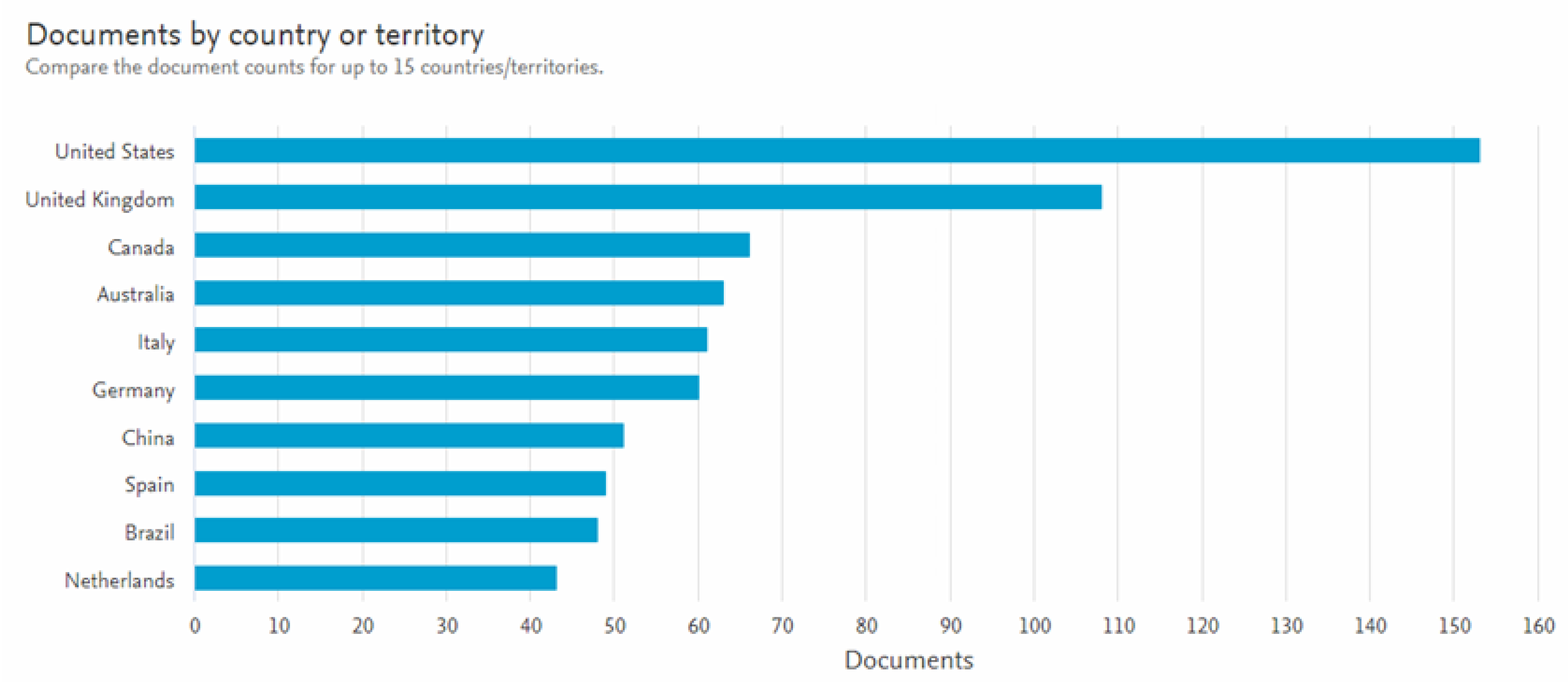
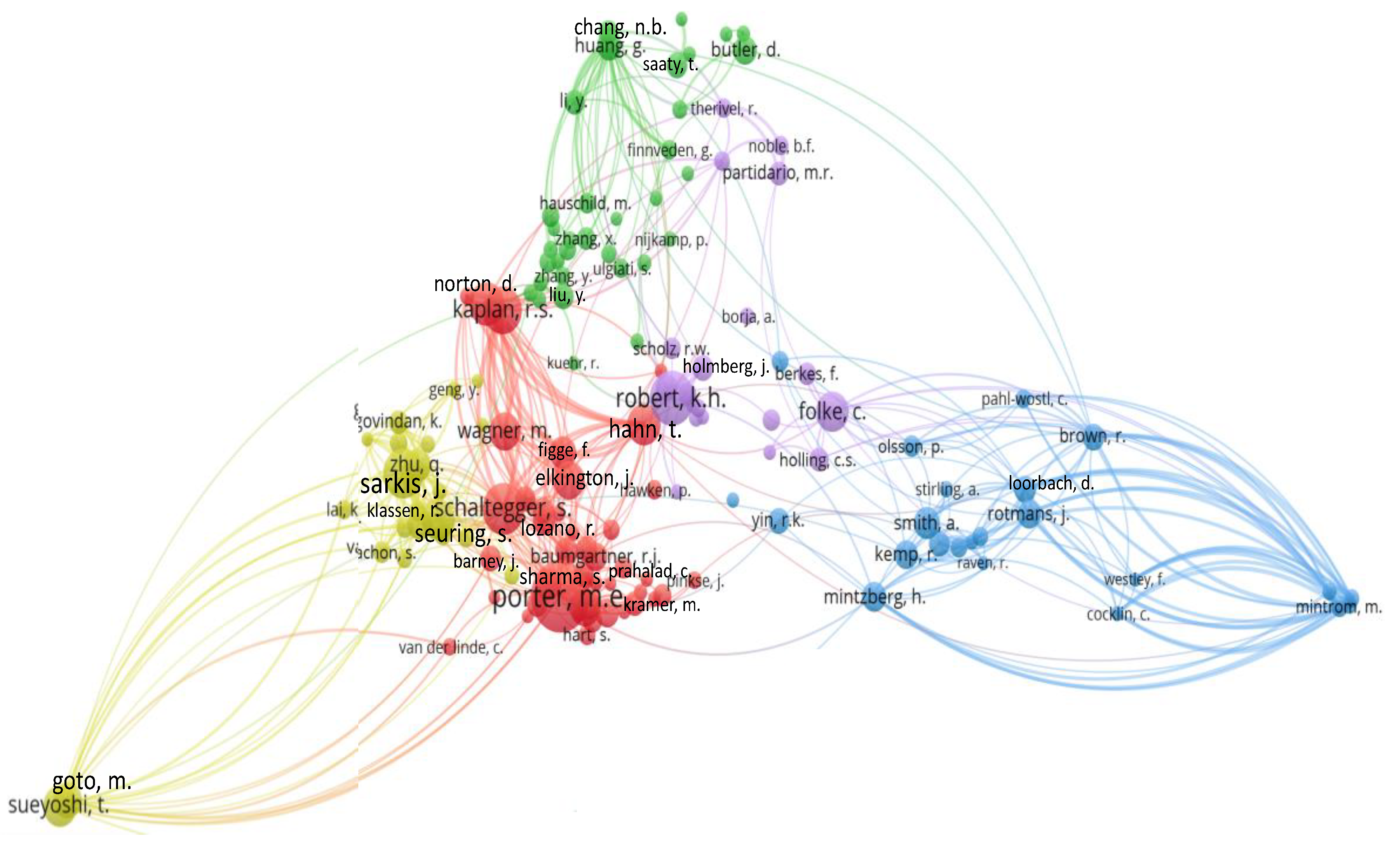
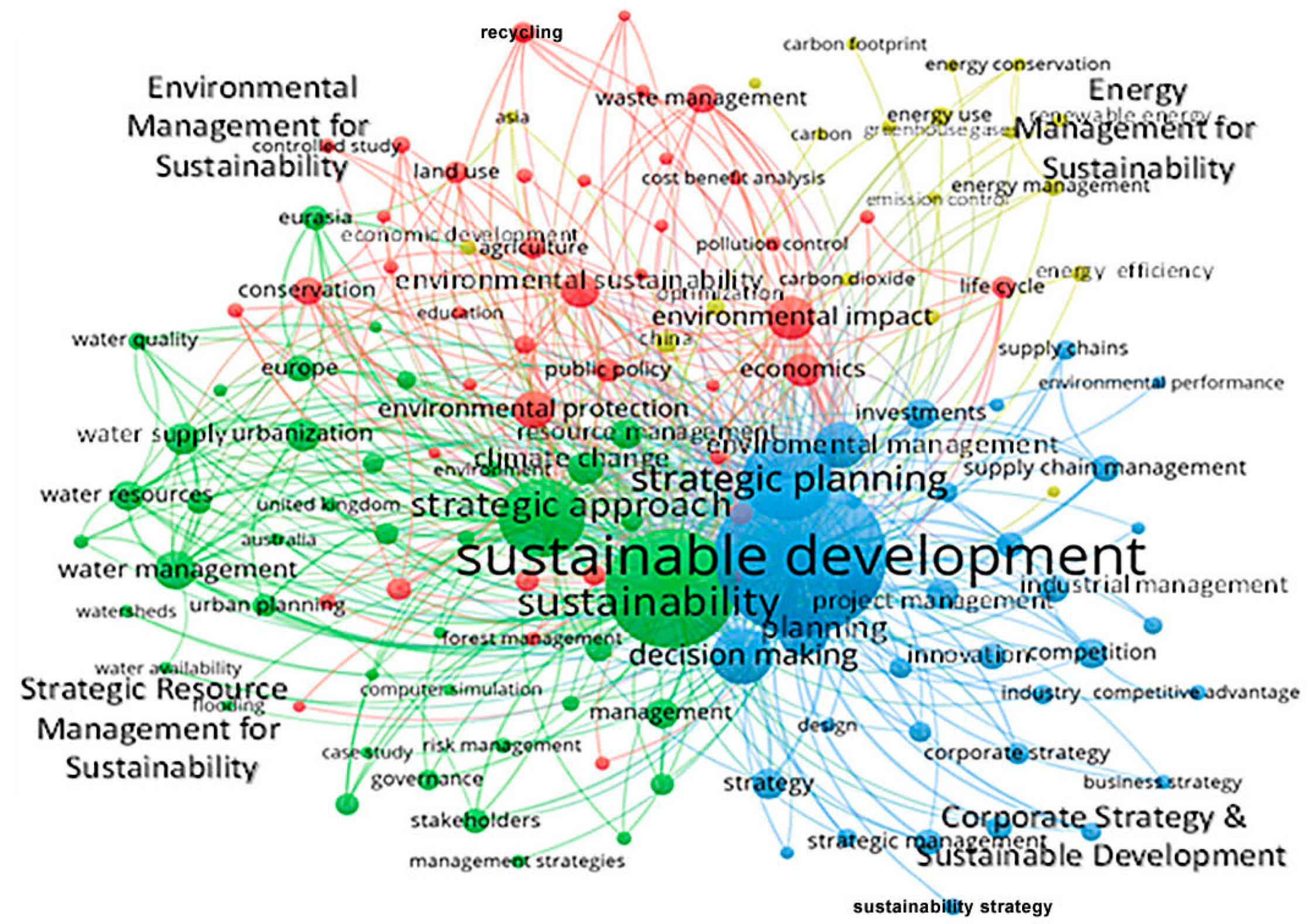

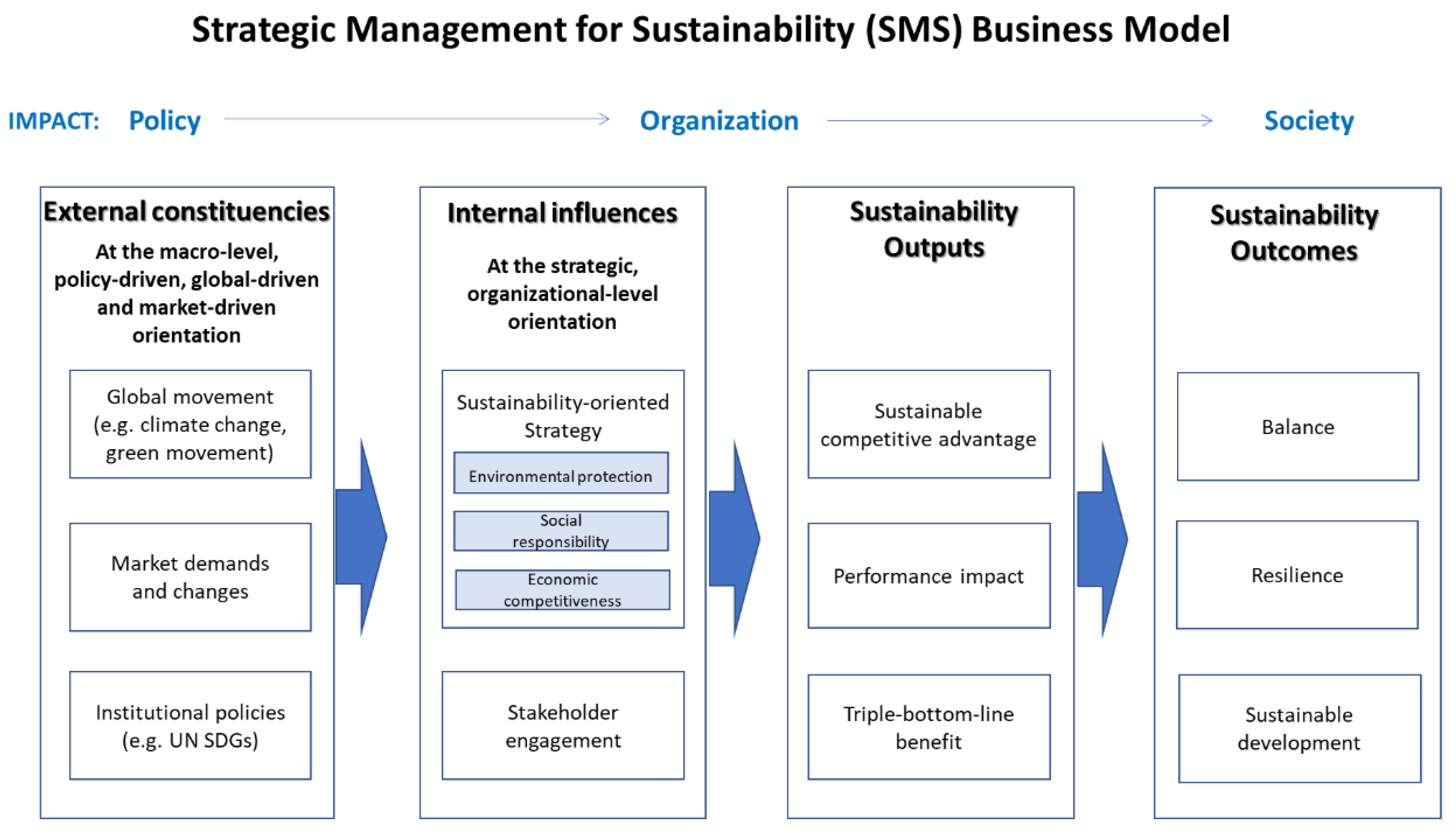
| Rank | Source (Country) | Domain | No. of Documents | Scopus Citations | Scopus Quartile |
|---|---|---|---|---|---|
| 1 | Journal of Cleaner Production (Neth) | Env Science | 59 | 1930 | Q1 |
| 2 | Environmental Science and Policy (Neth) | Geo, Plan & Dev | 2 | 515 | Q1 |
| 3 | Water Resources Management (Neth) | Civil & Struct Eng | 11 | 493 | Q1 |
| 4 | Landscape & Urban Planning (Neth) | Ecology | 8 | 436 | Q1 |
| 5 | Business Strategy and Environment (USA) | Bus & Int’l Man | 9 | 361 | Q1 |
| 6 | Resource, Conservation & Recycling (Neth) | Economics | 13 | 298 | Q1 |
| 7 | Energy (UK) | Building & Const | 9 | 281 | Q1 |
| 8 | Water Resource Research (USA) | Water Sci & Tech | 1 | 272 | Q1 |
| 9 | Journal of Industrial Ecology (USA) | Economics | 4 | 237 | Q1 |
| 10 | Science of Total Environment (Neth) | Env Chem | 12 | 234 | Q1 |
| Rank | Source (Country) | Domain | Scopus Co-Cites | Scopus Quartile |
|---|---|---|---|---|
| 1 | Journal of Cleaner Production (Neth) * | Env Science | 935 | Q1 |
| 2 | Strategic Management Journal (USA) | Bus & Int’l Man | 301 | Q1 |
| 3 | Journal of Business Ethics (Neth) | Arts and Humanities | 266 | Q1 |
| 4 | Business Strategy and Environment (USA) * | Business & Int’l Man | 259 | Q1 |
| 5 | Academy of Management Review (USA) | Bus, Man and Account | 249 | Q1 |
| 6 | Harvard Business Review | Bus, Man and Account | 219 | Q1 |
| 8 | Int’l Journal of Production Economic (Neth) | Bus, Man and Account | 206 | Q1 |
| 7 | Ecological Economics (Netherlands) | Economics | 198 | Q1 |
| 9 | Sustainability (Switzerland) | Geo, Plan & Develp | 168 | Q1 |
| 10 | Science (USA) | Hist and Phil of Science | 162 | Q1 |
| Rank | Author | Nation | Focus | Docs | Scopus Citation | Cite per Doc |
|---|---|---|---|---|---|---|
| 1 | Robèrt K. | Sweden | Env Science | 4 | 425 | 106.3 |
| 2 | Baumgartner R. | Austria | Env Science | 5 | 392 | 74.8 |
| 3 | Butler D. | UK | Env Science | 3 | 241 | 80.3 |
| 4 | Makropoulos C. | Netherlands | Env Science | 2 | 239 | 119.5 |
| 5 | Huisingh D. | USA | Env Science | 2 | 231 | 115.5 |
| 6 | Wang H. | China | Engineering | 2 | 213 | 106.5 |
| 7 | Ny H. | Sweden | Env Science | 4 | 206 | 51.5 |
| 8 | Broman, G. | Sweden | Engineering | 3 | 204 | 68 |
| 9 | Liu S. | China | Env Science | 4 | 174 | 43.5 |
| 10 | Schaltegger S. | Germany | Business & Man | 3 | 169 | 56.3 |
| 11 | Preuss L. | UK | Business & Man | 2 | 141 | 70.5 |
| 12 | MacDonald J. | Canada | Env Science | 2 | 122 | 61 |
| 13 | Pozzebon M. | Brazil | Business & Man | 3 | 120 | 40 |
| 14 | Petrini M. | Brazil | Business & Man | 2 | 188 | 94 |
| 15 | Rauter R. | Austria | Business & Man | 3 | 108 | 36 |
| 16 | Friedli T. | Switzerland | Business & Man | 2 | 100 | 50 |
| 17 | Hinz A. | Switzerland | Business & Man | 2 | 100 | 50 |
| 18 | Scherrer-rathje M. | Switzerland | Business & Man | 2 | 100 | 50 |
| 19 | Schrettle S. | Switzerland | Engineering | 2 | 100 | 50 |
| 20 | Sueyoshi T. | Japan | Decision Science | 2 | 91 | 45.5 |
| Rank | Author | Society | Subject Domain | SMS Focus | Type of Paper | Scopus Cites |
|---|---|---|---|---|---|---|
| 1 | Mcnie, E. | USA | Env Science | Information | Con | 499 |
| 2 | Wagener, T. | UK | Env Science | Resource Man | Con | 281 |
| 3 | Ahern, J. | USA | Env Science | Urban planning | Con | 246 |
| 4 | Iglesias, A. | SPAIN | Env Science | Resource Man | Con | 237 |
| 5 | Robèrt, K. | SWED | Env Science | Strategy | Con | 227 |
| 5 | He, W. | CHINA | Env Science | Strategy | Con | 219 |
| 6 | Baumgartner, R. | AUSTRIA | Env Science | Industrial policy | Con | 204 |
| 7 | Scholz, R. | SWITZ | Env Science | Strategy | Emp | 183 |
| 8 | Reynolds, M. | MEX | Env Science | Food security | Emp | 180 |
| 9 | Aragón-Correa, J. | SPAIN | Env Science | Strategy | Con | 175 |
| 10 | Makropoulos, C. | UK | Env Science | Resource Man | Emp | 161 |
| 11 | Subramoniam, R. | USA | Env Science | Supply chain | Rev | 154 |
| 12 | Moore, S. | USA | Env Science | Supply chain | Con | 154 |
| 13 | Maxwell, D. | UK | Env Science | Eco design | Con | 141 |
| 14 | Hahn, T. | SPAIN | Management | Corporate Sust | Rev | 140 |
| 15 | Tal, A. | ISRAEL | Chemistry | Resource Man | Con | 135 |
| 16 | Ny, H. | SWED | Env Science | Materials Man | Emp | 122 |
| 17 | Petrini, M. | BRAZIL | Management | Corporate Sust | Emp | 119 |
| 18 | Ceschin, F. | UK | Engineering | Product Man | Emp | 114 |
| 19 | Van Hoey, G. | BELG | Env Science | Eco man | Emp | 108 |
| 20 | Schrettle, S. | SWITZ | Engineering | Supply chain | Emp | 107 |
| Cluster | Name | Number of Scholars |
|---|---|---|
| Cluster 1 (Red) | Corporate sustainability strategy | 35 |
| Cluster 2 (Green) | Sustainable waste management | 18 |
| Cluster 3 (Purple) | Strategic sustainability systems | 9 |
| Cluster 4 (Blue) | Strategic sustainability management and entrepreneurship | 5 |
| Cluster 5 (Yellow) | Sustainability assessment strategy | 4 |
© 2019 by the authors. Licensee MDPI, Basel, Switzerland. This article is an open access article distributed under the terms and conditions of the Creative Commons Attribution (CC BY) license (http://creativecommons.org/licenses/by/4.0/).
Share and Cite
Suriyankietkaew, S.; Petison, P. A Retrospective and Foresight: Bibliometric Review of International Research on Strategic Management for Sustainability, 1991–2019. Sustainability 2020, 12, 91. https://doi.org/10.3390/su12010091
Suriyankietkaew S, Petison P. A Retrospective and Foresight: Bibliometric Review of International Research on Strategic Management for Sustainability, 1991–2019. Sustainability. 2020; 12(1):91. https://doi.org/10.3390/su12010091
Chicago/Turabian StyleSuriyankietkaew, Suparak, and Phallapa Petison. 2020. "A Retrospective and Foresight: Bibliometric Review of International Research on Strategic Management for Sustainability, 1991–2019" Sustainability 12, no. 1: 91. https://doi.org/10.3390/su12010091
APA StyleSuriyankietkaew, S., & Petison, P. (2020). A Retrospective and Foresight: Bibliometric Review of International Research on Strategic Management for Sustainability, 1991–2019. Sustainability, 12(1), 91. https://doi.org/10.3390/su12010091





